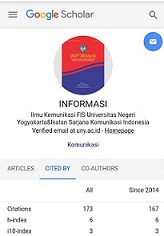Disembodied behavior and communication effectiveness in learning activity during the Covid-19 pandemic era
A. Adman, Universitas Pendidikan Indonesia, Indonesia
Hady Siti Hadijah, Universitas Pendidikan Indonesia, Indonesia
Fahmi Jahidah Islamy, Universitas Pendidikan Indonesia, Indonesia
Aeng Muhidin, Universitas Pamulang, Indonesia
Abstract
Keywords
Full Text:
PDFReferences
Abdullah, R. (2016). Pembelajaran dalam perspektif kreativitas guru dalam pemanfaatan media pembelajaran. Lantanida Journal, 4(1). Retrieved from https://jurnal.ar-raniry.ac.id/index.php/lantanida/article/view/1866/1387
Alawamleh, M., & Al-twait, L. M. (2020). The effect of online learning on communication between instructors and students during Covid-19 pandemic. https://doi.org/10.1108/AEDS-06-2020-0131
Antika, R., & Nawawi, S. (2017). Pengaruh model project based learning pada mata kuliah seminar terhadap keterampilan berpikir kreatif mahasiswa. Jurnal Pendidikan Biologi Indonesia, Volume 3 N, 72–79. Retrieved from https://pdfs.semanticscholar.org/e70c/3452e22a1c9436e79e0bd415034f2f0d10e5.pdf
Arshad, M. (2020). COVID-19 : It is time to be Thankful to our ICT Professionals. 9(2), 23–31.
Aw, S. (2019). Developing an evaluation instrument for assessing public relations practitioner performance in education institution. Malaysian Online Journal of Educational Management (MOJEM). 7(1) 20-36. : http://mojem.um.edu.my/index.php/MOJEM/a...
Aucejo, E. M., French, J., Paola, M., Araya, U., & Zafar, B. (2020). The impact of COVID-19 on student experiences and expectations: Evidence from a survey ☆. Journal of Public Economics, 191, 104271. https://doi.org/10.1016/j.jpubeco.2020.104271
Baer, J. (1998). The case for domain specificity of creativity. Creativity Research Journal, p. 11, No. 2, 173–177. Retrieved from http://users.rider.edu/~baer/CaseforSpecificity.pdf
Birgili, B. (2015). Creative and critical thinking skills in problem-based learning environments. 2(2), 71–80. https://doi.org/10.18200/JGEDC.2015214253
Chatterjee, I. (2020). Use of information communication technology by medical educators Amid COVID-19 pandemic and beyond. https://doi.org/10.1177/0047239520966996
Darihastining, S., Utomo, E. S., & Chalimah. (2021). The effectiveness of communication and online language disruption during the era of pandemic covid-19 in senior high school students in the implementation of learning cycle 7e The effectiveness of communication and online language disruption during the era of. https://doi.org/10.1088/1742-6596/1722/1/012024
Dewi, A., Imam, W., Kusumaningrum, D. E., Djum, D., Benty, N., Bambang, R., … Handayani, L. (2020). Student Learning Motivation: A Conceptual Paper. 487(Ecpe), 275–278.
Dobransky, N. D., & Frymier, A. B. (2015). Developing teacher‐student relationships through out of class communication. (June 2004). https://doi.org/10.1080/01463370409370193
Fatmawati, N. (2019). Komunikasi interpersonal guru dengan siswa dalam mengembangkan kreativitas belajar. (Doctoral Dissertation, Universitas Muhammadiyah Surakarta). Retrieved from http://eprints.ums.ac.id/73274/
Heath, C., & Luff, P. (1993). Disembodied conduct interactional asymmetries in video-mediated communication.
Koenig, R. J. (2010). A study in analyzing effectiveness of undergraduate course delivery: Classroom, online, and video conference. 3(10), 13–26.
Kong, H., Ho, K., Xiong, W., Ke, G., Oi, J., & Cheung, W. (2021). Impact of COVID-19 pandemic on international higher education and student mobility: Student perspectives from mainland China. International Journal of Educational Research, 105(November 2020), 101718. https://doi.org/10.1016/j.ijer.2020.101718
Kusman, M. (2019). Pengaruh komunikasi interpersonal guru terhadap motivasi belajar siswa di sekolah menengah atas. Al-tarbiyah: Jurnal Pendidikan (the educational journal). 29(1), 96–103.
Nasution, L. M. (2017). Statistik deskriptif. Jurnal Hikmah, 14(Ni. 1), 49–55. https://doi.org/10.1021/ja01626a006
Nisa, K. (2021). Efektivitas komunikasi guru terhadap motivasi belajar anak usia dini abstrak. Jurnal Obsesi : Jurnal Pendidikan Anak Usia Dini, 5(1), 229–240. https://doi.org/10.31004/obsesi.v5i1.534
Richardson, C., & Mishra, P. (2017). Learning environments that support student creativity: Developing the SCALE. Thinking Skills and Creativity. https://doi.org/10.1016/j.tsc.2017.11.004
Salo, Y. A. (2016). Pengaruh metode discovery learning terhadap keaktifan belajar siswa (Studi quasi eksperimen kelas VII SMPN 6 Banda Aceh). Penelitian Dan Pendidikan LPPM Universitas Pendidikan Indonesia, 16, No.3, 297–304. Retrieved from https://ejournal.upi.edu/index.php/JER/issue/view/582
Sari, Y. I., & Putra, D. F. (2015). Pengaruh model pembelajaran treffinger terhadap kemampuan berpikir kritis dan kreatif mahasiswa universitas kanjuruhan malang. Jurnal Pendidikan Geografi, 20(2)., 30–38. https://doi.org/http://dx.doi.org/10.17977/pg.v20i2.5065
Vlachopoulos, D. (2020). COVID-19: Threat or opportunity for online education? 10(1), 16–19. https://doi.org/10.18870/hlrc.v10i1.1179.
Wibowo, N. (2016). Upaya peningkatan keaktifan siswa melalui pembelajaran berdasarkan gaya belajar di SMK Negeri 1 Saptosari. Elinvo (Electronics, Informatics, and Vocational Education), 1(2), 128-139.
Wijaya, A. L. (2012). Pengaruh tingkat partisipasi kelas terhadap kinerja akademik mahasiswa. pendidikan ekonomi dan pendidikan, 9(April), 124–132. https://doi.org/https://doi.org/10.21831/jep.v9i1.4154
DOI: https://doi.org/10.21831/informasi.v52i2.54841
Refbacks
- There are currently no refbacks.
Copyright (c) 2022 Suwatno Suwatno, A. Adman, Hady Siti Hadijah, Fahmi Jahidah Islamy, Aeng Muhidin
Supervised by
Our Journal has been Indexed by:
Informasi by http://journal.uny.ac.id/index.php/informasi is licensed under a Creative Commons Attribution-NonCommercial 4.0 International License.















